Video analysis is an extremely effective was of analyzing a tennis serve – or any other tennis stroke, for that matter.
Just observing your stroke in slow motion can help you see where you got it right and where you got it wrong. Even more effective is a side-by-side comparison with a tennis serve that has good technical fundamentals.
I would like to thank Steven for graciously allowing me to use the footage from our lessons for this video analysis and article.

And since Steven is a medical doctor, we’re going to approach the process of improving the serve his way: We’ll look at the symptoms of what is going on with his serve; then, we’ll diagnose the causes of problems and prescribe some corrective drills to treat the serve.
The Symptoms – What Video Analysis Shows Us
If we just look at Steven’s serve and focus on the racket movements, we’ll see that he doesn’t really drop the racket low enough before accelerating upwards.

At first glance we may notice just a shallow drop and possibly a low toss
The rest of the serve looks fine; there are no major flaws to be seen at first glance.
So, if you rush into correcting the shallow drop in the serve, you may be trying to correct a symptom instead of finding a cause.
A more experienced eye will also notice a low toss that now suggests one of the reasons for the shallow drop. Steven simply doesn’t have enough time to complete a deeper loop/drop because the toss is so low.
A hint for a low toss is also a very early collapsing left arm which holds no tension or firmness, as you can see, but is very loose.
The Side-By-Side Video Analysis Reveals More
Once we observe Steven’s serve compared to mine, many more issues come to light and explain why Steven can’t find good power and consistency with his serve.
1. Racket position at the moment of the ball release
The issue of running out of time for having a deeper drop becomes even more obvious now.

The difference in the amount of backswing by the time of the ball release
You can see how much ground I cover with my backswing by the time I release the ball. Compare this with how much less ground Steven covers with his style of serving where he lags the hitting arm.
My racket is already very close to the drop, and I am in fact slowing down the swing before relaxing into the drop while Steven will have to tense up and rush in order to make it up to the contact point in time.
2. Maximum height of the toss
If we compare the toss height, we’ll see that Steven’s toss is lower than mine, so that compounds the “running out of time” problem that started with the lagging arm style of serving.

The difference in the height of the toss
If he at least had a high ball toss, then a lagging hitting arm style wouldn’t be so problematic.
3. How deep the racket drops
The shallow racket drop is now even more obvious in a direct side-by-side comparison.
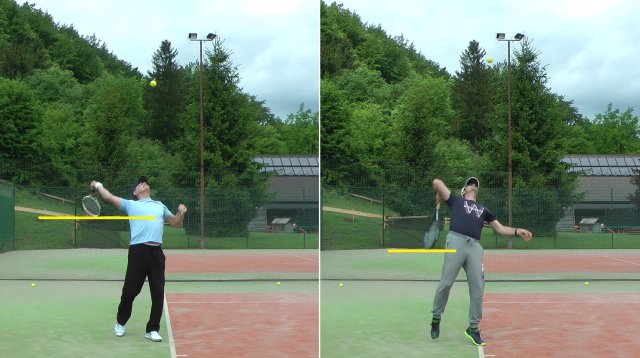
The difference in the racket drop. Shallow racket drop is caused by tension in the arm, not swinging it…
A shallow racket drop doesn’t give the player much distance to accelerate the racket. The player will therefore reach the ball at a low racket head speed.
4. Toss height above the contact
This is another illustration of the low toss but now in relation to the contact point.

Tossing 1 racket length above contact is a good guideline.
I toss the ball approximately 1 racket length above the contact point while Steven’s toss is probably just half of the racket length above the contact point.
It is, of course, possible to serve well with a low ball toss but you need a much quicker serving rhythm like Alexander Dolgopolov.
As always, there are exceptions to the rule, and one of them is Ivo Karlovic.
He serves with a very low ball toss and a lagging serving arm, but he still manages to execute the whole serve in that short amount of time.

Karlovic executes a series of movements in a short amount of time
As you can see in the diagram above, he manages to execute the whole complex arm movement in that short amount of time he has available.
That’s very difficult, and I would not recommend this serving style to a recreational tennis player.
Diagnosis – What Holds Steven’s Serve Back
In order to properly diagnose the player and the cause of the current problems, we need to look at mechanical issues.
Specifically, how do the biomechanics (in this case the throwing motion) function? Are there any physical limitations – like a previous injury, some injury hampering the player now or perhaps a lack of flexibility?
We also need to look at mental or psychological reasons because, in my experience, more than 50% of technical mistakes are caused by a wrong belief or an incorrect mental image of the stroke.
We cannot just correct the player mechanically as if they are robots that somehow got programmed incorrectly.
In fact, the player typically executes the stroke incorrectly because that’s how they see it in the mind’s eye.
It’s their mental image that’s wrong, and we need to find out where they got it wrong.
Only when we correct the mental image of the stroke can we begin to correct the player’s mechanics. Otherwise, they will always revert to their original mental image.
Mental Reasons
To give you an example, in Steven’s case, what was the incorrect belief, and what was the mental image he was following?
Steven listened to his coaches preach about being relaxed on the serve. He wanted to be as relaxed as possible and took it a bit too far.

You can take being relaxed too far when serving
I discovered that as I was telling him to load up, coil and create some tension in his body. He responded, “But, aren’t we supposed be very relaxed during the serve?”
So, that’s how I realized where he got it wrong by taking the relaxation idea too far.
Then I understood why his arm was just dangling down and why his left arm collapsed immediately after the toss, resulting in a very low toss and all the problems that followed.
When we serve, we have to initially load and coil in order to store energy in our muscles so almost nothing is relaxed in that stage except the hitting arm.
We can start the serve relaxed of course but once we wind up, almost everything is coiled and loaded which means that there is some tension in the body.
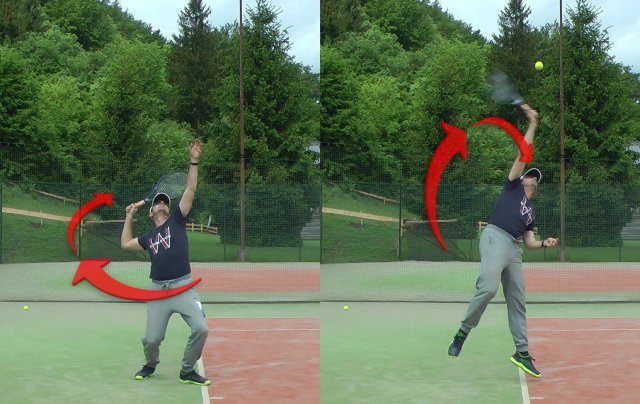
Storing energy before releasing is not a relaxed process
We then release this stored energy in an explosive manner by driving the legs up, uncoiling and letting the hitting arm follow. In the last bit of the serve, we add extra power with the pronation snap.
In terms of the mental image, Steven told me that he liked the serving style of Ivo Karlovic and Venus Williams, who have the lagging hitting arm.

Players always have a mental image of the stroke they copy.
He copied their style, not knowing that this type of serve is more complicated since the arms are not coordinated and since there is way less time to execute the serve well.
Once I showed Steven the side-by-side video of him and me serving, he realized how much time he was losing by keeping his hitting arm down in the initial phase of the serve.
2. Physical / Mechanical Reasons
In terms of physical or mechanical reasons for the incorrect serve, Steven told me that he’d had a shoulder surgery.
Even though the shoulder may be healed now, he may still be unconsciously avoiding a stretch in the shoulder since such movements had caused so much pain in the past – both with the injury and after the surgery.
The brain tends to protect previously injured parts by not allowing the full range of motion in order to prevent another injury.
Second, we tested his throwing motion, and I saw that his arm motion was good but that he was not engaging his body enough into the throw. As a result, he was not finding power for the serve in his body.
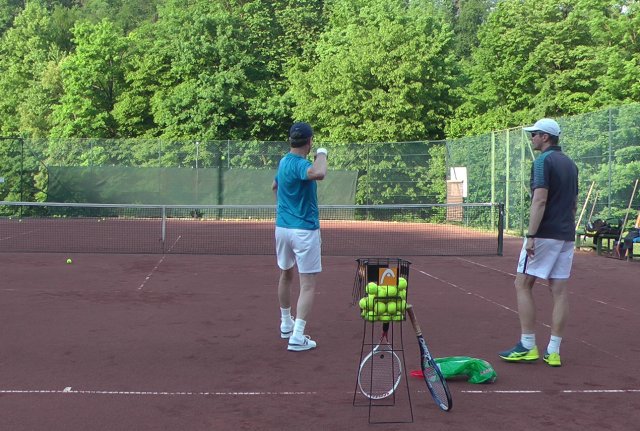
Steven could engage his body (rotation) more into the throw
So to recap, we have diagnosed the causes of the lack of power on the serve, a shallow drop and a low toss. These issues are caused by:
a) Mental factors
- believing that one has to very relaxed in the serve which causes the dangling arm and the tossing arm to collapse immediately after the ball release, resulting in a low toss
- having a mental image of Ivo Karlovic’s serve, which again causes a dangling and lagging hitting arm
b) Physical factors
- shoulder surgery that possibly prevents a stretch in the shoulder
- the biomechanics of the throwing motion is lacking body engagement and hence power
Prescription Drills – Higher Toss And Better Throwing Motion
Now that we have a clear understanding of what has been holding Steven’s serve back, we can we start working on correcting the serve.
The mental causes have been addressed since Steven has seen the pros and cons of the lagging arm serve and is creating a new mental image of the serve. He also understands that he needs to create tension and store energy in the preparation phase of the serve and not look for complete relaxation.
Now we need to improve his throwing biomechanics and increase the height of his toss – and in the process, we will also help him feel how to stretch the core muscles in his body, store energy and then release it.
Correcting The Toss
When I zoom in a bit to see the difference in the beginning of the toss, you can see how much less of a swing Steven has than I do.
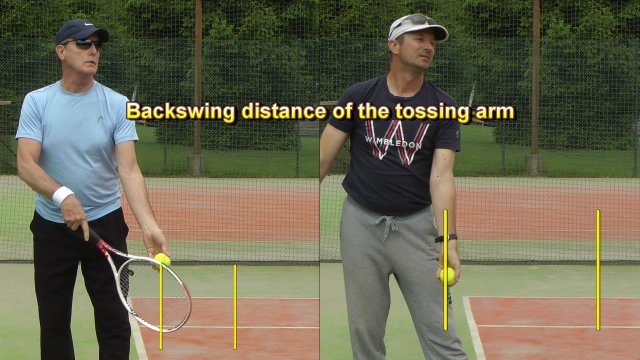
Having some backswing with the tossing arm makes it much easier to toss
By not swinging back towards him, he doesn’t bring any energy to the tossing arm, so the tossing arm basically has to initiate the toss from zero speed.
If the tossing arm starts the toss from a static position without any help of the swing or the body swaying in some way, then there is a high chance of problems.
The toss may be low or jerky and therefore inconsistent.
So, the first thing to keep in mind is to make the toss more dynamic – Steven needs to get a bit of a swing backwards and then initiate the toss.
Because players struggle with an inconsistent toss, they believe being still while tossing will result in an accurate toss since the body movement will not disturb the accuracy of the toss.
That is true only with extreme body movements.
But, in fact, when one is very still with the body as they are tossing the ball, they bring no energy to the tossing arm and they move unnaturally.
That results in a very stiff and unresponsive tossing arm, which responds with jerky movements. That is what actually causes an inconsistent toss.
The more you try to still yourself during the toss, the worse it will get.
You need to sway a little bit and create some swinging motion in your tossing arm in order to help it toss the ball.
I personally hardly feel my tossing arm; I feel that most of my toss is done through the body movement.
So, one way to feel how to engage the body in the toss more is to look for a stretch in the front part of the body, all the way from the left hip and up to the armpit.

You'll toss higher even if you just focus on stretching this front part of the body
Now if I just told Steven to toss higher, not much would have changed.
In my experience, words don’t work. We can’t teach a sport where the body needs to execute certain movements by talking to the person.
We need to talk to the body directly through feel-based exercises as only then can we expect quick and noticeable changes.
You can use two very simple exercises to stimulate and engage the tossing arm and also to engage the body to stretch more.
a) Toss a Heavier Ball
The first one is to simply toss a heavier ball, like a one-pound medicine ball.
If you don’t have a medicine ball, you can take a small bottle of water that weighs about the same and practice your toss with it.

No instruction required, just try to toss the ball high
This extra weight will force you to engage more of your muscles to toss it higher.
After some repetitions with this heavy ball, tossing a tennis ball will be much easier.
b) Stretch an Elastic Band As You Toss
The second drill you can do is to use an elastic band, step on it to hold it in place and simulate a toss by stretching it up with your tossing arm.

Another very simple way of stimulating the arm and the body to engage more
Overcoming the resistance of the band again stimulates the tossing arm and the side of the body underneath where Steven should feel a stretch.
He can then later rely on this feeling of a stretch, and he will get into the right position. Stretching upwards for a bit longer is the same concept as I have already explained in the “keep lifting” toss idea.
The final goal of instructions and corrections is always to go as soon as possible from thinking to feeling.
You can then also combine the stretch with the rubber band with a throw of a light medicine ball or with a shadow swing of the racket.
Improving The Throwing Motion
The way I would work on the throwing motion and the general biomechanics of the serve is with the medicine ball in the bag drill – or by throwing old rackets.
Since I’ve already made a video on the topic of serve fundamentals, I will just briefly show you the drills we did with Steven.
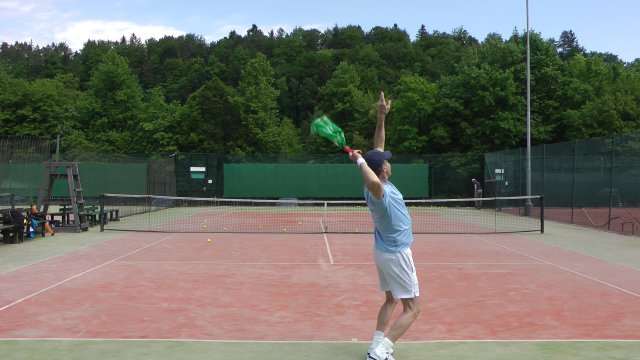
Another simple drill but very effective in improving your serve biomechanics
This drill helps the player synchronize the movements and create the speed of the ball – and eventually the racket – through a flowing fluid motion and not through jerky muscling of the ball.
If you’re a recreational tennis player and you struggle with your serve, then this is the most important exercise you should be doing.
The Battle – Between Old And New Movements
Now I want to show you a part of the learning process that I call The Battle.
It’s the battle between old and new movements, or old and new motor programs in the brain.
Let’s return now just to the ball toss drills for the left hand to show you an example of the battle.
The exercises with the medicine ball and the rubber band will help you overcome the old habits briefly, but do not expect that you’ll do the movement correctly from now on.
It will take quite some time now for you to battle it out with the old habits.
The final clip with Steven is 5 minutes long as I want to show the real struggle and the reality of battling a habit that has been forming for years.
If you’ve watched the clip you saw how challenging it is to just toss the ball higher.
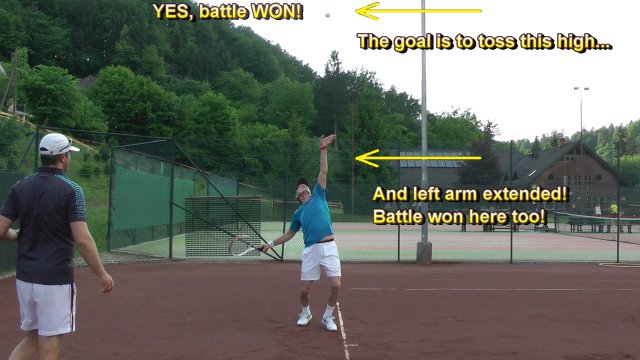
On one attempt everything is great...
Even when Steven managed to toss the ball really high and it seemed like he now got it, he already tossed the ball low again on the next attempt.
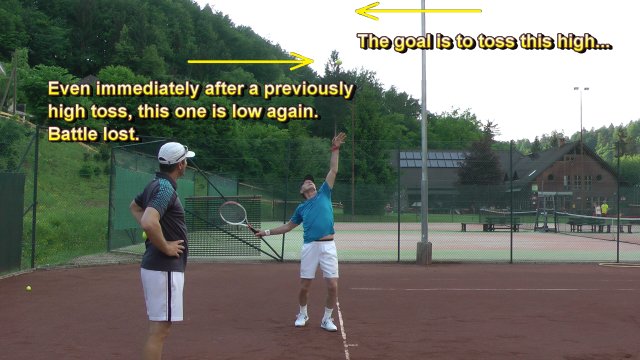
... and on the next attempt it's back to the old ways.
You will have to go through such a battle hundreds if not thousands of times before you overcome a habit.
Do not believe in any instant tennis instruction that is being marketed to you.
Changing a movement is an incredible battle. On Day 1 of the battle, you’ll be mostly losing.
But once you know how to attack the old habits – and the only effective way I know is through feel-based exercises and not through words – then you’ll be on the right track.
And once you’re on the right track, you can only get better.





There are literally thousands (and counting) of video tips/instructions from literally hundreds of coaches regarding the Serve on the internet. But you won’t find or see even ONE video or coach that approaches & addresses the problems & solutions regarding the serve (analysis/diagnosis/prescription) like Tomaz just did here!! I am infinitely amazed @ the ingenious methods, descriptions, angles/approaches Tomaz communicates, utilizes, etc in order to “break through” (deconstruct) both the physical (bio-mechanical) & mental (mind). I believe we are observing, witnessing a bona-fide coaching genius and future Legend. We are incredibly lucky! Thank you Tomaz!!
You have to watch to the very end…..but T makes a superlative comment regarding “Tennis” that I’ve also always believed and agree with! He did’nt say it and/or was’nt thinking about it when he made the claim…..but it nonetheless (will) places him at the very Tip Top of the Coaching & Sporting world!
Thanks a lot for your kind feedback, Ambrose!
I am always asking myself: “What is this player thinking or imagining?”
Their flawed technique is partly a result of their incorrect image of the stroke.
So I have to “poke” 😉 deep into the players psyche to see what they think about the stroke or tennis in general.
Once we get to the bottom of it, the process of correcting the stroke can start…
Tomaz, I have been working on my serve for a good three years. from online to my local pro private lessons. While they all helped, Tomaz’s breakdown is the best. Thanks for the great instruction. Now if I can just toss the ball higher, increase my racket drop and hit up on the ball at contact . Thanks
Thanks, Fay!
Make sure you do this funny drill a lot:
https://www.feeltennis.net/tennis-serve-fundamentals/
It will do more for your serve than doing complex technical corrections…
Thanks Tomaz – you are one of the few coaches that use feel based exercises. I think this approach really resonates with my learning style. Really appreciate how your structure and formulate your instruction and videos.
Hi Tomaz,
Thanks for very helpful tips, as always!
I was wondering whether the ball toss height should be the same for both serves – first and second? I understand you still would need to create a body stretch for the second serve as well. right?
Hi Boris,
Yes, the ball toss is the same for any type of serve, you just toss it a bit differently.
Here’s an article on that topic:
https://www.feeltennis.net/tennis-serve-toss/
Hi Tomaz,
I applaud your video and your passionate nature toward helping people become the best that they can be in tennis.
You tennis coaching skill has been seen and listened to by many people. It is really superb to know that you reply and communicate with everybody. Always giving confidence, you are one in a million.
Best wishes,
Graham
Much appreciated, Graham!
Hi Tomaz. I watched this on the court this morning. I immediately responded to the “fully loaded” metaphor, stopped the video and tried it. Since I can’t see myself I just felt it. The legs, abdomen and shoulders. I wanted my body to be fully stretched in those 3 places and even on the first try I got results. The serve had more power.
I continue to serve for 5 min and my body didn’t revert to the lesser ‘loaded’ stance. I think it’s cause it just felt right and easy and the results buoyed me. Prior to watching this when I served my intention was always: bend your as much is possible & arch your back as much as possible.
This works better. July 16-21
I observed one more thing in the video which wasn’t spelled out: Tomaz’s elbow pointing to the sky. My intention is always: drop the racked all the way to almost touch your butt. But when I tried this I felt that the timing of the service and the contact point improved instantly. This correction was not as easy to maintain but I am working on it. Thank you for this video. Guy
Thanks so much for the feedback, Guy!
It’s very helpful for other players to read what and learn what helped you personally to improve your serve.
An inconsistent toss has always been a problem for me. Nowhere else in any lessons live or online have a seen that the tossing arm has to have some “sway” or movement and not start from a static fixed position. That point and to use the “entire body” to lift the ball are the precious takeaways.
And, you cannot do this without being relaxed. This has helped greatly!
Thanks, Tomaz
Very nice demonstration of what you wanted the learner to take away from the video. Tomaz, you are an amazing coach and one of the very few selfless instructors. Thank you.
With the details you showed on split screen, i believe what you said of 20hrs of edition. we appreciate it.
Good day.
Mohammed
Thanks, Mohammed! Keep in touch, more videos on the way.
Hey, you foot-faulted! (1st side-by-side pic)
Naw, just kidding you, Tomaz. You are, of course, hands down THE best video tennis instructor on the Internet and therefore, the world!
I wish I could fly you over here and have you coach me full time for a week or two every year. I better go check my lottery ticket – who knows, maybe I can!
All the best to you, Sir – Remguy, Montreal Canada
Thanks to both you and Steven. The area of “The Battle” is especially helpful to realize how strong the tendency to return to ingrained and inefficient habits is. That was an extremely illuminating insight for me!
It isn’t that you are just doing Feel based corrections but you have managed to diagnose and explain it in a way that makes sense. Using video of yourself is one thing but sometimes I think it’s too much content of yourself that you may not have the expertise to diagnose or correct. But in using video to show you what you are doing versus what you think you are doing (mental aspect as you said) then I see such a high correlation.
This video has me excited. Ready to do more hard work! Unlearning muscle memory due to bad habits and previous sports is such a hard thing. Keep up the great work Tomaz!